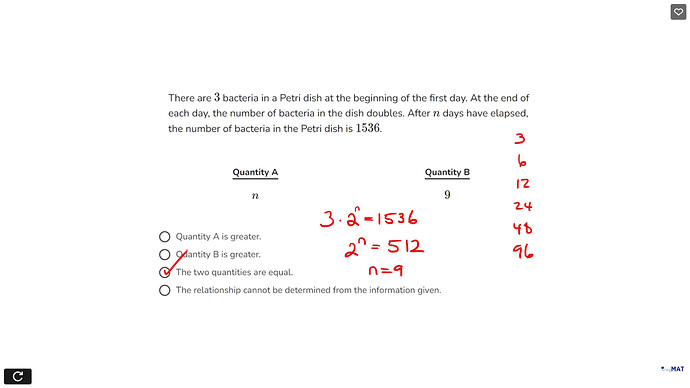Isn’t the answer for this B, because n=1 on the 2nd day only. So accordingly, when n equals 9 wouldn’t it be the 8th day?
So n = 1 → 1 day has elapsed and i’m guessing you agree that we’ll have 6 bacteria by then. If so, then isn’t the answer clear?
No, on day 1 there are only 3 bacteria’s. So n must be 0, which means on day 1, n=0 & day 2, n=1 & day 3, n=2 & so on…
Therefore 1536 = 3.2^9 which means it’s on day 8
So the answer would be (B)
Nothing from what I said above disputes this. n represents the number of days elapsed and not day n and frankly the semantics do not even matter. It just matters that you know some values like (n, y) = (1,6), (n,y) = (2,12), and so on. More elucidation pertinent to this follows right after the table below.
Yeah and so this agrees with what i’ve mentioned above. According to you, a suitable table would look as follows:
\begin{array}{|c|c|} \hline n & y = 3 \cdot 2^n \\ \hline 0 & 3 \\ 1 & 6 \\ 2 & 12 \\ 3 & 24 \\ 4 & 48 \\ 5 & 96 \\ 6 & 192 \\ 7 & 384 \\ 8 & 768 \\ \color{red}9 & \color{red}1536 \\ \hline \end{array}
\rule{20cm}{0.4pt}
Basically, you want to find an exponential function such that y = ab^n passes through (n,y) = (1, 6) and (n,y) = (2,12), which gives you a = 3 and b = 2.
Thus, you’re dealing with y = 3 \cdot 2^n for which n = 9 yields y = 1536.
What? That makes no sense. You just plugged in n = 9 and then you say it’s day 8. If anything, day 10 makes more sense because from your argument, you have n + 1 = day_count. Regardless, we’ve discussed why 10 doesn’t work in context.
